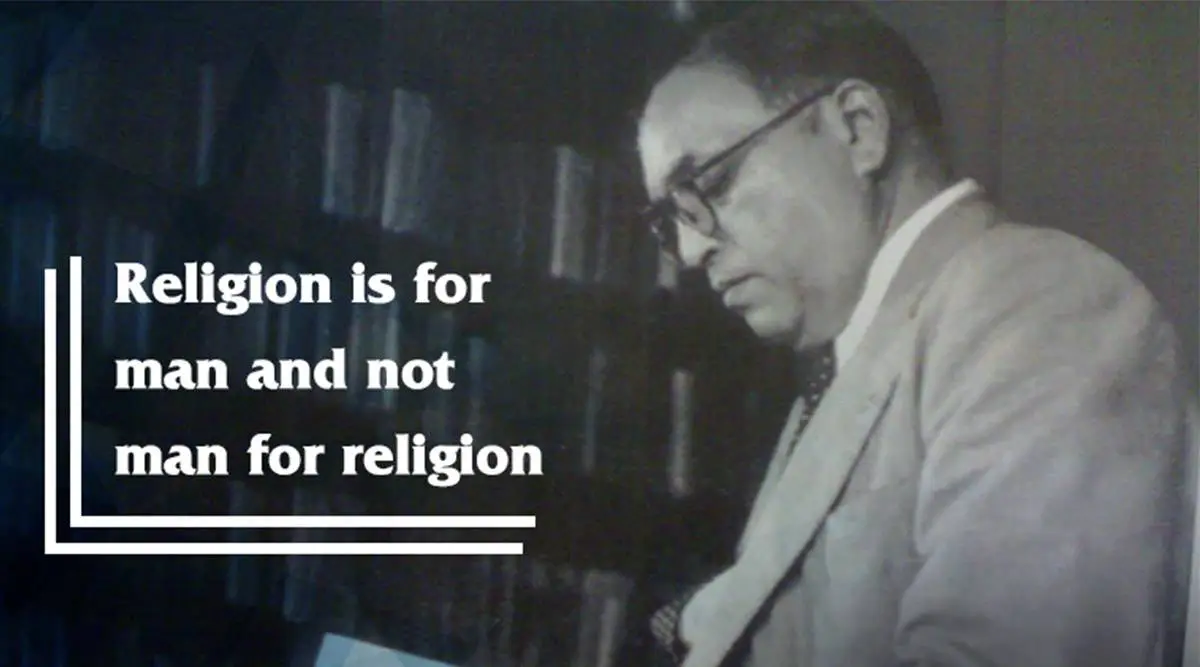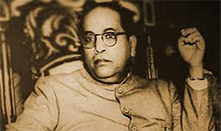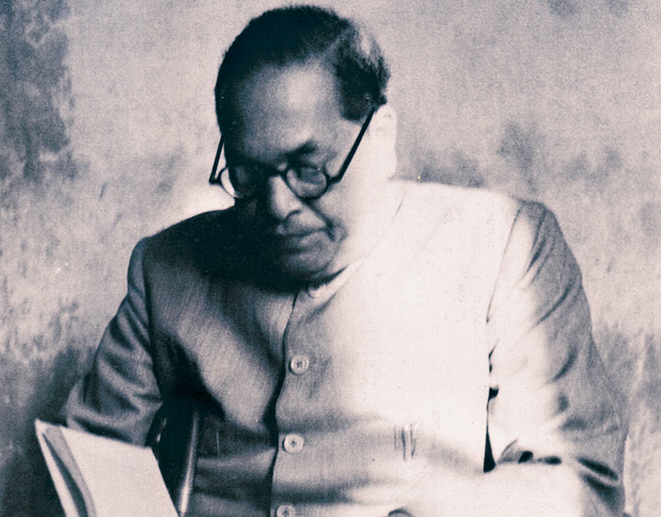FEB 14 2020 | 05:29PM | ARTICLE
Sign Petition

Babasaheb Dr. B. R. Ambedkar: A Case for Nobel
"Babasaheb Dr. B. R. Ambedkar has been victim of process of reductionism and ‘black-out’ in India and at thereby at the international level as well. India as a nation recognized his contributions by conferring on him the highest Civilian Award Bhart Ratna in the year 1990, 34 years after his mahaparinirvan (his death). However, the world has yet to recognize his larger contributions to Human Rights, peace and amity of the universe. Therefore, this petition is a humble attempt to highlight Dr. B. R. Ambedkar’s seminal contributions to the larger humanity from local to global and hence a worthy case for Nobel Peace Prize.
Reductionism & Blackout of Babasaheb Ambedkar
Let us first understand how has Dr. B.R. Ambedkar has been victim of process of reductionism and blackout in Indian Society? By reductionism we mean that Babasaheb has been either understood only from a very narrow perspective of Dalit Messiah or as an intellectual who was only engaged with caste or annihilation of caste. Further, many intellectuals at the most called him as the chief architect of the Indian Constitution. In this context few individuals still have doubt that he is the father of Indian Constitution. Third, reductionism also comes to fore when intellectuals and academia could not recognize different shades of his thoughts and perspectives with which he has tried to understand social realities of Indian and world society. Last but not the least the reductionism of his personality and deeds can be seen in the way various stages and dynamic of his movement have not been noticed by the media, academia and intelligentsia. ‘Blackout’ means his omission from seminal literary, academic texts, visual and artistic works. The blackout sometimes looks by design and sometimes by default.
Let us take a few examples to prove the first point of ‘reductionism’.
1. He has been reduced to a Dalit leader and an intellectual who was only engaged with annihilation of caste. The first example comes from Eleanor Zelliot’s Ph.D. work where she has analysed him and his movement from a particular caste perspective and a leader of Mahar caste not even the leader of whole ex-untouchables communities.
2. In 1990s journalist Arun Shaurie who went on to become cabinet minister in Vajpayee Govt. published a book, ‘Worshiping the False God’ to prove the point that Ambedkar was not the chief architect of the Indian Constitution. He was only a draftsman and called him stooge of British.
3. The third example of reductionism comes as late as 2014. This time a literary personality Arundati Roy in her effort to popularise Babasaheb’s writings, could see Ambedkar ‘Annihilation of Caste’ as his most valuable contribution. The reductionism can be further substantiated from the point that her introduction was more voluminous than the Babasaheb’s text ‘Annihilation of Cate’.
Understanding Ambedkar’s Blackout
Having given you a few examples to prove the point how Ambedkar has been the victim of ‘reductionism’, let us take a few examples to prove the point of ‘blackout’.
1. The first literary work is Mulk Raj Anand’s novel ‘Untouchable’ in which Babasaheb Ambedkar has been completely blacked out and Gandhi is hailed as the emancipator of untouchables. It is a fact that by the time Mulk Raj Anand had written his text Ambedkar already arrived on the horizon of emancipation of Dalits.
2. As far as blackout from academic texts is concern there are several examples in this sphere. However, the first text in question is G. S. Ghurey’s ‘Caste and Race in India’ first published in 1932 from Routledge and Kegan Paul, London. The book was published one and a half decades after Ambedkar’s ‘Caste, Genesis, Mechanism and its Spread published from USA in Antiquary Journal. Even after its first edition Ghurey published a number of other editions also, however he never to cognizance of Babasaheb writings on Caste. Same case is with Louis Dumont’s, Homo Hierarchicous, first published in 1970s with several publications thereafter.
3. The third example of blackout of Babasaheb Ambedkar can be observed from Richard Attenborough directed film Gandhi in 1982 which is considered to be epic and a historical film. It was nominated for Academy Awards in eleven categories and won in eight categories including Best Picture and Best Director Award. However, in this film Ambedkar was totally blacked out. However, it is a fact that Gandhi had picked up removal of untouchability as one of the agenda of his movement after 1930s because of his conflict with Ambedkar. Gandhi’s tug of war with Ambedkar in Round Table Conference in London, his fast unto death against Separate Electorates to Dalits, singing of famous Poona pact in September 1932 and then Gandhi and Ambedkar dialogue on ‘Annihilation of Caste’ are highly publicised episodes which remain fresh in public memory. These episodes are not easy to be obliterated from public memory. And yet Ambedkar is completely blacked out in Gandhi.
The blackout of Ambedkar in Gandhi is serious because when Jabbar Patel made a feature film on Ambedkar in the year 2000, Gandhi was present everywhere. Therefore a moot question emerges in this context -If Ambedkar had no relevance in Gandhi then how come Gandhi becomes relevant in a film on the life of Ambedkar? Hence, this raises a doubt. Is there a deliberate attempt to blackout Ambedkar in the film Gandhi? Why can’t he been shown in the film beside Gandhi? Second, corollary to that is can Ambedkar be analysed independently on his own?
Decoding Babasaheb’s
If these are a few examples to prove the point that there is general pattern of ‘Reductionism’ and ‘Blackout’ of Babasaheb then is there any alternative perspective to understand the colossal personality of Dr. B. R. Ambedkar? In this context we can highlight at least six perspectives to understand his colossal personality and his contributions to not only to Indian society but to the whole World. These reasons are:
a. The way Babasaheb Ambedkar has been revered by his followers and supporters
b. The way he was appreciated by Columbia University while awarding honorary L.L. D. Degree in the year 1952
c. The way western Social Scientists have tried to analyse his academic and political wisdom
d. The nobel peace prize winner Dr. Amartya Sen dedicate his Nobel prize to Dr. B. R. Ambedkar
e. The horizons, shades, epistemologies and approaches of his thought.
f. Nature and dynamics of his movements launched by him
g. The contributions he has made for nation building
h. Ambedkar Emerges a Global Icon
Babasaheb Ambedkar: As revered by his followers
Let us briefly take these facts one by one to prove the point. At the outset let us understand the dimensions of Babasaheb’s personality which his followers highlight and revere. Babasaheb’s followers address him as, ‘Vishva Vibhooti’ (Global Icon) ‘Bodhisatva’ (Like Buddha), Bharat Rattan (Highest Civilian award of the country), ‘Samvidhan Nirmata’ (framer of the constitution) Babasaheb Dr. B. R. Ambedkar’. That means he is revered as, a spiritual leader who has achieved a higher status of ‘Bodhisattav’ by treading path of Buddha and practicing the same. Second, this address also highlights his higher civilian achievement in the Indian society where he was conferred country’s highest civilian award ‘Baharat Rattan’ (gem of India). The supporters deliberately add the epithet in front of his name Dr. to highlight his educational achievement which he had at that point in time without any other being near to him. His followers affectionately call him ‘Babasaheb’. Apart from this he is also revered as the maker of Indian constitution (Bharat ke Samvidhan Nirmata). Last but not the least he is being addressed also as ‘Global Icon’. This is the repertoire of his aura highlighted by his followers which count in millions, yet he is reduced only to a Dalit leader by the mainstream media, academia or intelligentsia. That is why they feel that he is not given the respect which is due to him.
Babasaheb Ambedkar as referred by Formal Institutions
If this is the informal way in which Ambedkar is revered by his followers let us observe how he was referred by the formal institution like University. For instance, how did University of Columbia refer him while awarding honorary degree some sixty five years back on June 5th, 1962. The citation letter re as follows, “ Bhimrao Ramji Ambedkar LL.D. ...for three years a graduate student in this university, receiving the doctorate in Political Science; subsequently a student of the Inns of Court and the University of London, obtaining a doctorate in economics; for the past three decades a barrister, university professor ...as a framer of the constitution...one of India’s leading citizens...a great social reformer and a valiant upholder of human rights.”
How has he been evaluated by western social scientists?
In the same vein we should also take into account how a few western social scientists have highlighted Ambedkar’s achievements in the sphere of higher education in comparison to other leasers of that time. Let us see these lines Gandhi did not claim much book learning...Nehru, on the other had enjoyed higher education Gandhi lacked...it would be unfair to compare Nehru to Ambedkar, intellectually head and shoulder above most of the Congress leaders, in part due to far more serious training ...at LSE and Columbia , to read whom is to enter a different world (Anderson 2012: 51-52).
Apart from taking cognizance of his academic credential Anderson also took note of his political foresight. According to Anderson when Gandhi, Nehru, whole Congress and even Muslim League did not have a clue about the outcome of India’s struggle for independence Ambedkar alone has a solution of Hindu-Muslim conflict. In his own words ...Ambedkar...in 1944...published the only serious work...which would determine the outcome of the struggle for independence- Pakistan or Partition of India whose references range from Renan to Acton to Carton; from Canada to Ireland to Switzerland stand a devastating indictment of intellectual poverty of Congress and its leaders. Critical to Muslin introversion, alert to Savarkar’s Hindutva, contemptuous of myth of pan-religious amity, Ambedkar did not advocate separation of two communities, but he proposed referenda to determine popular wishes and in the event that Muslims insisted on it sketched the boundaries he thought might endue...”(Anderson 2012: 89-90).
In the same vein Cosimo Zene’s edited volume, ‘The Political Philosophy of Antonio Gramsci and B.R. Ambedkar’ which includes contributions of at least fourteen social scientists is testimony to the fact that his larger ideas are being recognized and compared with other philosophers of the world. The book has an interdisciplinary approach and published by Routledge London and New York. It has yet to be published in India. Such were the academic, social, political and educational achievements and contributions of Ambedkar accepted by the people in general and the western academia in particular. In spite of these, mainstream media, intelligentsia and academia in India have reduced Ambedkar to the status of a Dalit leader. They have wilfully blacked out his aforesaid ideas and qualities.
Different shades of thoughts of Ambedkar
It is in this context, we would also like to highlight Ambedkar’s various shades of thoughts present in his writings and speeches. This will help us to decode Ambedkar’s larger ideas. We can at least observe ten shades of thoughts in various writings and speeches of Ambedkar. These are, Social, Political, Economic, Religious, Gender, Educational, Legal and Constitutional, Developmental, Human Rights specific to marginalized, This is only a suggestive list and one can find out number of other shades of thought in his writings and speeches published by Maharashtra Government posthumously.
Epistemology of Ambedkar’s thought
Ambedkar has produced empirical knowledge and not produced speculative philosophy. His empirical knowledge has at least eight sources of data collection. These were, Archaeological sources, Indological sources, Government reports and other documents, Reports of Commissions and Committees, News paper clippings, Books and Journals, direct observation and people’s perception and discussions. Again there are number of permutation and combinations of these sources in production of knowledge by Babasaheb.
Perspective and Approaches of Knowledge
Apart from different shades of thoughts and epistemology of knowledge we can observe that Babasaheb Ambedkar had adopted multiple approaches for producing his knowledge. We can observe at least four approaches in his writings. These are, Civilization, Historical, Evolutionary and Comparative approach for production of knowledge. To take one example to prove the point, for instance while understanding religion in India he began by tracing the origin in different civilization. He then differentiated between religion and theology. He also used Max Muller, Emile Durkheim, and Max Weber etc. to understand meaning of religion and tribal society and modern society.
Having discussed the perspective of the lecture, the process of reductionism and blackout of Babasaheb’s larger ides and thought; we have seen four added facts on the basis of which we can argue that there is process reductionism and blackout, of Babasaheb Ambedkar. These were how was he revered by his followers, how have institutions viewed his personality and deeds, how have various social scientists his contributions, the different shades, epistemology, and perspectives of his production of knowledge. Instead of engaging such vast canvas of his methodologically produced knowledge the social scientists of Indian origin have reduced him to an individual who has written only on caste.
Different Stages and Phases of Babasheb’s Movements
The Social Reformer
There is a tendency among scholars and layman alike to reduce Babasaheb Ambedkar’s movement as an undifferentiated monolithic whole. However, if we analyse his activities a little bit closely we can easily divide Babasaheb movement in five different yet interrelated stages/phases. These phases were complementary and supplementary to his efforts for achieving equality, liberty, fraternity and justice not only for the Dalits but for the other social groups in general and Indian society in particular. Each phase enriched his experience in fighting against the existing inequalities of the Hindu social order. The periodization of his leadership is also necessary to understand the rational of his changing socio-political stances in his long struggle.
The first phase began in early 1919 when he gave a memorandum to franchise commission asking for self- representation of Dalits and this continued till 1930. During this period he acted more like a social reformer while fighting against the rigid caste system and its draconian practice of untouchability. He was convinced by the knowledge of the world history that “history bears out the proposition that political revolutions have always; been preceded by social and religious revolutions” that is why he launched various types of social movements. To begin with Ambedkar formed a society the Bahishkrit Hitkarini Sabha, society to serve the interests of outcastes on July 20, 1924 which could place their social and political problems before the government.
Second in this phase Babasaheb launched Mahar satyagrhas for taking water from a public tank. Another very unique event that took place during the Mahad Satyagrah was burning of the ‘Manusmriti’ the sacred law book of the Hindus. Justifying his action of burning the ‘Manusmriti’, Ambedkar said in the 3 Feb. 1928 issue of his Bahishkrit Bharat, that his reading of the Manusmiti “had convinced him that it was abusive and insulting in its treatment of the Shudras and it did not even remotely support the idea of social equality. To burn a thing was to register protest against the idea it represented”. In the same vein in this phase Ambedkar organised the largest and longest Satyagraha on 2nd march, 1930 at Nasik for the Dalits, entry to the ‘Kala Ram’ temple. Around 15,000 Mahars and Chambhars had assembled at Nasik. But the temple had to be closed for about a year to keep them away from entering it. The Parvati Satyagraha in Poona also met the same fate.
Although Ambedkar was leading a movement for temple entry, but he never wanted to enter in them in real sense of the term. In his own words, “I did not launch the temple entry movement because I wanted the Depressed Classes to become worshippers of idols which they were prevented from worshipping or because I believed that temple entry would make them equal members in and an integral part of Hindu society. So far as this aspect of the case is concerned, I would advise the Depressed Classes to insist upon a complete overhauling of Hindu society and Hindu theology before they consent to become an integral part of Hindu society. I started temple entry Satyagraha only because I felt that was the best way of energizing the Depressed Classes and making them conscious of their position. As I believe I have achieved that, therefore, I have no more use for temple entry. I want the Depressed Classes to concentrate their energy and resources on politics and education” (Elinor Zelliot, From Untouchables to Dalits, Manohar Publication 1992:131, India).
Ambedkar And his Political Movements
The second phase started in 1930 and ended with his joining the Constituent assembly. During this period he acted more like a political leader emphasized the need of establishing fundamental rights of the Dalits, acquiring political rights of the Dalits but also establishing a few political parties to realize these political rights. For instance defining the interests and rights of the Dalits, Ambedkar opined that, “The untouchables are usually regarded as objects of pity but they are ignored in any political scheme on the score that they have no interest to protect. And yet their interests are the greatest. Not that they have large property to protect from confiscation. But they have their very persona confiscated. The socio- religious disabilities have dehumanized the untouchables and their interests at stake are therefore the interests of humanity. The interests of property are nothing before such primary interests… The untouchable is not even a citizen. Citizenship is a bundle of rights such as (1) personal liberty, (2) personal security, (3) right to hold private property, (4) equality before law, (5) liberty of conscience, (6) freedom of opinion and speech, (7) right to assembly, (8) right of representation in a country’s Government and (9) right to hold office under the State … These are the interests of the untouchables” (Ambedkar writing and speeches Vol. I 1979: pp.255-6, Mumbai Government).
Secondly during this phase he also went on to participate in Roundtable Conference in London and won the ‘Separate Electorate’ for the Dalits. The separate electorates gave Dalits the power of two votes. Through one vote they would elect their own caste representatives and through other they could elect the general caste representative. This was unique because it gave them their true representative. However, Gandhi as the representative of the Indian National Congress did not accept the separate electorate for the Dalits and went on to fast on to death. This lead Ambedkar to enter in a pact called ‘Poona Pact’ in September 1932. Responding to fast unto death of Gandhi Ambedkar issued to the press statement on Gandhi’s fast to expose his tactics, “suffice it is to say that although Mr. Gandhi declared a fast unto death, he did not want to die. He wanted very much to live” (Ambedkar Writings and Speeches Vol. 9, 1991 p. 88 Govt. of Maharashtra). Further he argued that the fast created a problem of how to save Gandhi’s life. All eyes turned on Ambedkar for the same. To this Ambedkar reflected, “As to myself it is no exaggeration to say that no man was placed in a greater and graver dilemma than I was then. It was a baffling situation. I had to make a choice between two different alternatives. There was before me the duty, which I owed as a part of common humanity, to save Gandhi from sure death. There was before me the problem of saving for the untouchables the political rights, which the Prime Minister had given them. I responded to the call of humanity and saved the life of Mr. Gandhi by agreeing to alter the Communal Award in manner satisfactory to Mr. Gandhi” (Ambedkar 1991 Ibid: 88).
After Poona pact ‘Separate Electorates’ were converted to ‘Joint Electorates’ which exists even today. In spite of the fact Ambedkar had on the independent political rights for the Dalits because of which they could represent themselves in politics. With this achievement Ambedkar formed Independent Labour party in 1936 and contested Bombay Assembly elections and won number of seats. The in the elections gave him and Dalits a new confidence because of which in 1942 he launched the All Scheduled Federation to broaden his political national base. During this phase he had discussion and letter exchanged words with Ram Manohar Lohia to launch a united political party. However Ambedkar could not do so because of his untimely death on December 6th, 1956. But he was quite successful in laying the foundation of Republican Party of India which was formed in 1957 after his mahaparinirva (death).
In his political party Babasaheb Ambedkar also established women wing and used to have regular and simultaneous sessions and used to address women cadres. He groomed many women leasers in his party who later on went on to become Members of Legislative Assembly. Such as Babasaheb’s Politics. He never mixed Religion with Politics and tried to mobilise people on secular issues.
The Chief Architect of Indian Constitution
The third phase of Babasaheb’s movement started in 1946 when he entered in the Constituent Assembly and became the Chairman of the Drafting Committee. Ambedkar’s entrance into the ‘Constituent Assembly’ even against his will is regarded as the third phase of his leadership in the sphere of Dalit amelioration. As the chairman of the ‘Drafting Committee’ Ambedkar bore the burden of not only drafting the various democratic principles but also of defending them clause by clause in the ‘Constituent Assembly’ debates. The ‘Constituent Assembly’ worked for two years, eleven months and seventeen days since it first met on 9th December 1946. That means Ambedkar had to be present on all these days. Further, in this regard one can make out amount of labor and time Ambedkar had to put in preparing the Constitution by his following reflection.
Ambedkar argued that draft Constitution, as prepared by the constitutional Adviser as a text for the ‘Drafting Committee’ to work upon, consisted 243 Articles and 13 Schedules. In its final form, the draft Constitution contained 395 Articles and 8 Schedules. The total number of Amendments to the draft Constitution tabled was approximately 7635 (seven thousand six hundred and Thirty five). Of them, the total number of amendments actually moved in the house was over 2473 (Two thousand four hundred and seventy three) (Ambedkar Writings and Speeches Vol 13, 1994: P. 1206, Govt. of Maharashtra). That means he read all the 7635 amendments and discarded 5162 (five thousand and one hundred and sixty two) amendments and incorporated 2473 amendments to produce our constitution a herculean task with extraordinary intellect.
The members of the ‘Constituent Assembly’ have accepted the amount of labor, both intellectual and physical, that was put in by Ambedkar in the preparation of final shape of Constitution of India. For instance, parsing Ambedkar’s contribution T.T. Krishnamachari, one of the senior members of the ‘Constituent Assembly’ from the then Madras Presidency opined in the assembly that, “Mr. President Sir, I am one of those in the house who have listened to Dr. Ambedkar very carefully. I am aware of the amount of work and enthusiasm that he has brought to bear on the work of drafting this constitution …The house is perhaps aware that of the seven members nominated by you, one had resigned from the house and was replaced. One died and was not replaced. One was in America and his place was not filled up and another person was engaged in state affairs and there was a void to that extent. One or two people were away from Delhi and perhaps reasons of health did not permit them to attend. So, it happened ultimately that the burden of drafting this Constitution fell on Dr. Ambedkar and I have no doubt that we are grateful to him for having achieved this task in a manner which is undoubtedly commendable” (Ambedkar Writings and Speeches Vol.13 1994: P.72 Govt. of Maharashtra). This as the contribution of Babasaheb Ambedkar in the making of the Indian Constitution and yet people are not ready to accept his contributions.
Further during third epoch he also joined to Nehru cabinet and became the first law minister of independent India but resigned in October 1951. In his capacity of Law Minster of the country Babasaheb wanted to bring in Law which he had titled as ‘Hnidu Code Bill’ to empower the Hindu women as a whole. The bill was envisaged to secure a dignified and equal status for the Hindu women with number of clauses. There were rights of inheritance and maintenance. There were laws against dowry. Instead of Polygamy Monogamy was made legal. The Hindu marriage became a contract instead of sacrament. The consent of wife was to be made compulsory in the event of adoption. He had also mooted that like son wife and daughter should be given share in the property of husband and father respectively. Ambedkar in his proposed Hindu code Bill attempted to, “Consolidate the different categories of Srtidhan into one single category of property and laid down the uniform rule of succession” (Ambedkar writings and speeches Vol 14 (I), 1995: p.7, Govt. of Maharashtra.).
The Religious Renounce
In the fourth phase of his leadership started (1952-56) Babasasaheb emerged as a renouncer and religious leader. He started mobilizing his supporters to embraced Buddhism and finally returned to its fold on 14th of October 1956 before attaining nirvana on December 6th, 1956. Ambedkar’s conversion to Buddhism has been criticized as a political act. Again it is an attempt to belittle his vision. Zelliot has replied very aptly so such critics. She argued, ““What possible political advantage does conversion offer”? Conversion to Buddhism immediately cuts off…deserving governmental benefits …to Untouchable castes. Ambedkar’s delayed conversion came long after the period of combining the conversion idea with political expediency, and by then reference to conversion as a political threat had lost its significance. Instead, it had reference to the great Asian Buddhist world, the reputation of Buddhism as an important religion both in India and the West and the possibility of Buddhism as a moral force” ( Elinor Zelliot, From Untouchable to Dalits, 1992, P. 195, Manohar, Ne Delhi).
We are aware of the fact that Babasaheb well aware ‘Sciences of Religion’ and had deep understanding of different religions of the world. He had read Max Muller, Max Weber, Emile Durkheim etc. on religion. He also knew about theology and rituals as two parts of the religion. However, he as convinced about the necessity of religion in the society. According to him religion is the most significant institution which helps in social control. Law cannot have full control in the society. That is why he argued religion is very essential for the Dalits as well. But that religion should be egalitarian religion. That is why he chose Buddhism because he as of the opinion that it was based on egalitarian principles like-equality, liberty, and fraternity. Second, there is no mediator between god and people. People can their own guide. There is no church and no idea of soul and rebirth. Hence Buddha’s gospel will be most effective emancipatory ideology for the Dalits who need psychological and social uplift. That is why Ambedkar choose Buddhism as the religion for the Dalits.
Ambedkar after conversion was called to participate at world Buddhist Conference during 15-16th November, 1956 in which he participated. Ambedkar’s last effort to popularise the Buddhist faith in India was a book ‘Buddha and His Dhamma’. He tried to explain the tents of Buddhism, in this book, in most simple language for the common masses and tried to eliminate the Brahmanical interpretation which had intruded in Buddha’s life.
Ambedkar the Educator
Apart from these four shades there is fifth shade of his movement which cut across all the four stages/ phases of his movements is the phase here he is acting like an educator. Who can forget his famous slogan, ‘Educate, Agitate and Organize’ which reverberates in every meeting on or about Babasaheb. During this period he brought out at least five newspapers to educate his people. The first newspapers was ‘MOOK NAYAK, (Hero of the Dumb) started in 1920, ‘BAHISKRIT BHARAT, (Ex-Communicated Indians) started in 1927 till 1929, SAMATA (Equality) started in 1928, JANATA (The People) started in 1930 ,and last but not the least PRABUDHA BHARAT, (The Enlightened Indian) started in Feb 1956. Through these he wanted to awaken the downtrodden masses from their age-old lethargy and inaction and unite them. He asked the government to grant concessions, scholarships and other facilities to Dalit students. During this phase he founded the People’s Education Society in Bombay in 1945. In 1946 he established Siddharth College of Arts and Science to provide basic and non-discriminatory and scientific education to Dalits and others. An important lesson which we can infer from this phase of his movement is that he never wanted to propagate vocational education as is being popularised by the present BJP led government.
Ambedkar the Nation Builder
It is in this context his larger ideas of Nation Building are very important. It is so because ‘Nation’ for marginalized sections of South Asian societies is an idea of emancipation from the yolk of colonialism and exploitative social structure of Indian society although he moves towards universalism with the conversion to Buddhism in October 1956.
Is India A Nation?
At the outset Ambedkar like many others was of the opinion that India was not a nation but nation in the making (Ambedkar 1994: 1217). He made this fact very clear as early as in 1930s during his conflict with Mohandas Karamchand Gandhi. According to Ambedkar, “The Anglo-Indians were never tired of proclaiming that India was not a nation” (Ambedkar1990: 29). It is true that the colonial administrators did not view Indian subcontinent as one nation. Strachey (1888:5) wrote, “…there is not and never was an India…no Indian nation, no people of India”. In the same vein Sheeley (1883: 255) commented, ‘India is … only a geographical expression like Europe or Africa. It does not make the territory of a nation and a language, but the territory of many nations and languages’ (Strachey (1888) and Sheeley (1883) as quoted in Oommen 2000:
1). Ambedkar also opined that even Dr. Rabindra. Tagore, the national poet of Bengal also agreed that India was not a nation (Ambedkar 1990: 29). That is why he emphasized that, “First of all there is no nation of Indians in real sense of the word. The nation does not exist, it is to be created, and I think it will be admitted that the suppression of a distinct and a separate community is not the method of creating a nation” (Ambedkar 1991: 412). Again while speaking on the 26th November 1949 when the Constituent Assembly was going to pass the Constitution of independent India Ambedkar argued that, “[in the past] politically-minded Indian resented the expression “the people of India.” They preferred the expression “the Indian nation.” I am of opinion that in believing that we are a nation, we are cherishing a great delusion” (Ambedkar 1994: 1217).
Why is India not a Nation?
In this context it will be worth mentioning the main reasons because of which Ambedkar refused to accept Indian was not a nation. It would also be worth considering how did he define the nation and what was his scheme for building the Nation?
Relationship between Hindus and Dalits; Hindus and Aborigines
At the outset Ambedkar wondered, “How can people divided into several thousands of castes be a nation?” (Ambedkar 1994: 2017). Arguing at another place Ambedkar had highlighted the fact how castes were hurdle in the process of nation building. In his own words, “There is an utter lack among the Hindus of what the sociologists call “consciousness of kind”. There is no Hindu consciousness of kind. In every Hindu the consciousness that exists is the consciousness of his caste. That is the reason why the Hindus cannot be said to form a society or a nation” (Ambedkar 1979: 50-51). Ambedkar further went on the explain why are castes anti national. In his own words, “The castes are anti-national in the first place because they bring about separation in social life. They are anti-national also because they generate jealousy and antipathy between caste and caste” (Ambedkar 1994: 2017). Not only that Ambedkar also underlined that, “Caste is… the real explanation as to why Hindu has let the” thirteen million aborigines in the midst of civilization as savage without giving him medical aid to reform them and make them good citizens (Ambedkar 1979:53). Therefore he suggested that “…we must overcome all these difficulties if we wish to become a nation in reality. For fraternity can be a fact only when there is a nation” (Ambedkar 1994: 1216-7).
Relationship between Hindus and Muslims
If that was the case of relationship between Hindus, Dalits and aborigines Ambedkar further analyzed, whether, “…there are enough affinities between Hindus and Muslmans to constitute them into a nation…”(Ambedkar 1990:31). Ambedkar wondered, “Are there any common historical antecedents which Hindus and Muslims can be said to share together as matter of pride or as matters of sorrow…so far they have been just two armed battalions warring against each other. There was no common cycle of participation for a common achievement. Their past is a past of mutual destruction- a past of mutual animosity, both in political as well as in religious fields” (Ambedkar 1990: 35). Ambedkar was clear that while Hindus revere Prthiviraj Chauhan, Rana Pratap, Shivaji in history the Muslims revere likes of Mohammed Bin Qasim, Aurenzeb etc. In religious field argued he, “…the Hindus draw their inspiration from the Ramayan, the Mahabharat, and Geeta. The Muslamans…derive their inspiration from Quran and Hadis” (Ambedkar 1990”36).Further, he reiterates that, “In the absence of common historical antecedents, the … view that Hindus and Muslaman form one nation falls to the ground. To maintain it is to keep up a hallucination” (Ambedkar 1990:37).
Relationship between Hindu Provinces
Along with analyzing the nature of relationships between people belonging to various castes and communities Ambedkar also analyzed the relationship between various provinces with Hindu majority. According to him, “The Hindu provinces have no common traditions and no interest to bind them. It cannot be pretended that the Sikhs have any tenderness for the Bengalees are the Rajputs for the Madrasis. The Bengali loves only himself. The Madrasi is bound by his own world. Maratha who set out to destroy the Muslim empire in India became menace to the rest of the Hindus whom they harassed and kept under their Yoke for nearly a century…On the other hand, the differences of language race and the conflicts of the past have been the most powerful forces tending to divide them” (Ambedkar 1990: 12-13). That is why Ambedkar concluded. “It is true that the Hindus are getting together and the spirit moving them to become one united nation is working on them but it must not be forgotten that I have not yet become a nation they are in the process of becoming a nation"(Ambedkar 1990:13). In the same vein Ambedkar had highlighted that, “The Muslims have openly declared that they do not want to have any Central Government in India…The Muslims feel that to accept one Central Government for the whole of India is consent to place the Muslims Provincial Government Under a Hindu Central Government and to see the gain secured by the creation of Muslims Provinces by subjecting them to a Hindu Government” (Ambedkar 1990:12). That is why quoting Sir Mohammad Iqbal’s position at Round Table Conference Ambedkar opined that, “The Muslim way of escaping from the tyranny of Hindu Centre is to have no Central Government in India at all” (ibid:12).
Ambedkar’s Notion of Nation: Sentimentality as its Basis
Taking leaf Ambedkar rejected race, language and country as a basis for constituting a nation. He argued, “As a matter of historical experience, neither race, nor language nor country has sufficed to mould a people into a nation” (Ambedkar 1990:34). Quoting Renan he argued, “that race must not be confused with nation…The truth is there is no pure race; …Racial facts, important as they are in the beginning, have a constant tendency to lose their importance. Human history is essentially different from zoology. Race is not everything, as it is in the sense of rodents and felines” (ibid: 34). As for language, “Language invites re-union; it does not force it The United States and England, Spanish America and Spain speak the same language and do not form single nation. On the contrary, Switzerland which owes her stability to the fact she was founded by the assent of her sever counts three or four languages. In man there is something superior to language,-will. The will of Switzerland to be united in spite of the variety of her language, is a much more important fact than a similarity of language, often obtained by persecution” (ibid: 34). As to common country Ambedkar quoted Renan, “It is no more the land than the race that makes a nation. The land provides a substratum, the field of battle and work; man provides the soul; man is everything in the formation of that scared thing which is called a people. Nothing of material nature suffices for it” (ibid: 34).
Having shown that race, language and country do not suffice to create a nation Ambedkar quoted Earnest Renan to point out what is more is necessary to constitute a nation. According to Renan “A nation is a living soul, a spiritual principle. Two things, which in truth are but one, constitute the soul, this spiritual principle. One is in the past, the other in the present. One is the common possession of a rich heritage of memories; the other is the actual consent, the desire to live together, the will to preserve worthily the undivided inheritance which has been handed down…The nation, like the individual, is the outcome of a long past of efforts, and sacrifices, and devotion… A heroic past, great men, glory,-these form the social capital, upon which a national idea may be founded. To have common glories in the past, a common will in the present: to have done great things together, to will to do the like again, - such are the essential conditions for the making of a people (Renan quoted in Ambedkar 1990:35).
Further Renan argues that,
“In the past an inheritance of glory and regrets to be shared, in the future a like ideal to be realized; to have suffered, and rejoiced, and hoped together; all these things are worth more than custom houses in common, and frontiers in accordance with strategical ideas; all these can be understood in spite of diversities of race and language... suffering in common is a greater bond of union than joy. As regards national memories, mourning’s are worth more than triumphs; or they impose duties, they demand common effort” (Renan quoted in Ambedkar 1990:35).
Such are the characteristics of nation according to Ambedkar which is more or less identical definition of Marcel Mauss, as discussed above, which is without any markers of religion, race, language or territory rather based on sentiments or will.
Difference between Nationality and Nationalism
Apart from giving the characteristics of nation Ambedkar went on to differentiate between nationality and nationalism. Accordingly, “…there is a difference between nationality and nationalism. They are two different psychological states of human mind. Nationality means ‘Consciousness of kind’ awareness of the existence of that tie of Kinship” (Ambedkar 1990:39). Further he has explained that, “Nationality is a social feeling. It is feelings of a corporate sentiment of oneness which makes those who are charged with it feel that they are kith and kin. This national feeling is a double edged feeling. It is at once a feeling of fellowship for one’s own kith and kin and an anti-feeling for those who are not one’s own kit kin. It is a feeling …which on the one hand binds together those who have it, so strongly that it over-rides all differences arising out of economic conflict or social gradation and, on the other, severs them from those who are not of their kind. It is a longing not to belong to any other group. This is the essence of what is called a nationality and national feeling” (Ambedkar 1990: 31). On the other Ambedkar elucidated that, “Nationalism means ‘the desire for a separate national existence for those who are bound by this tie of kinship…there cannot be nationalism without the feeling of nationality being in existence” (Ambedkar 1990: 39). It is here that Ambedkar Highlighted the relationship between Nationality and Nationalism as well. According to him although nationalism cannot exist without nationality but, “…the converse is not always true. The feeling of nationality may be present and yet the feeling of nationalism may be quite absent…For nationality to flame into nationalism two conditions must exist. First, there must arise the will to live as a nation. Nationalism is the dynamic expression of that desire. Secondly, there must be a territory which nationalism could occupy and make it a state, as well as cultural home of the nation” (Ibid:39).
Ambedkar’s Scheme of Nation Building: A shift towards Institutionalism
If we analyze the idea of Indian nation in the light of the characteristics of nation as discussed above, two things become amply clear. On the one hand there is utter lack of national feeling between Dalits, Other Backward Castes, aborigines and the so-called upper caste Hindus. On the other hand, there is no common antecedent between with Muslims and Hindus. Thirdly, Indian women were also subjugated and were excluded from social, political and economic institutions because of caste and patriarchy. In this way we can conclude form the aforesaid analysis that Ambedkar identified lack of nationality hence lack of fraternity within the aforesaid groups. Probably, it is here Ambedkar is moving away from notion of nation based on sentimentality to notion of nation as given by Gellner, who has argued that people become because of genuine, objective, practical necessity, “Nation” may emerge from “shared exclusion” and ‘culture, pigmentation, etc’ which provides means of identification for the under-privileged class (Gallner quoted in Jaffrelot 2002: 10). Jaffrelot (2002) has used this aforesaid theory to prove the separatism of Muslims in British India, crystallization of Bengali nationalism in Pakistan, and also assertion of Sindhis in Pakistan. Hence, if we have to integrate this separatist tendencies emerging out ‘genuine objective and practical necessity’ and ‘shared exclusion’ then we need to provide people those necessary conditions which can subside their separatist assertion for an independent state. We have discussed the case of Hindu women here separately however they should be considered as subsection of Hindu society only. In the light above the writer of this article is of the view that one has to take following steps for nation building.
Four characteristics of nation building
Realization India is not a nation
The first step in Ambedkar’s scheme of nation building is the realization of the fact that India was not a nation. In his words, “The sooner we realize that we are not as yet a nation in the social and psychological sense of the word, the better for us. For then only we shall realize the necessity of becoming a nation and seriously think of ways and means of realizing the goal” (Ambedkar 1994: 2017).
Forgetfulness
Second step in the process of nation building will be forgetting the turbulent and warring past. In this context taking a clue from Renan, Ambedkar emphasized the importance of forgetfulness as a factor in the creation of a nation can be observed in France where union of Northern and Southern France took place despite a century of conflict. But today very one has forgotten it and they both have become one nation. Therefore, Renan concluded that, “the essence of the nation is, that all its individuals should have things in common; and also that all of them should hold many things in oblivion” (Rennan quoted in Ambedkar 19090:37). Perhaps Ambedkar was using this fact for both so-called upper caste Hindus and Dalits on the one hand and for Hindus and Muslim on the other. Although, a very difficult preposition, but Ambedkar proposed expecting that all the sections of the Indian society will forget their past of animosity and hatred to make a positive beginning.
Freedom of Servile classes is also a reality
The third aspect of Ambedkar’s scheme of nation building was that all the subjugated collectivities should be granted their legitimate rights so that they should be free from subjugation. In his own word, “Philosophically it may be possible to consider a nation as a unit but sociologically it cannot but be regarded as consisting of many classes and the freedom of the nation if it is to be a reality must vouchsafe that the freedom of the different classes comprised in it, particularly those who are treated as servile classes” (Ambedkar 1991: 201-202).
Breaking the Monopoly of the governing elite
The fourth characteristics of Ambedkar’s scheme of nation building was the process of dismantling the privileges of the governing elite and breaking their monopoly on the ‘political power’. He cautioned the Constituent Assembly about the dangers of monopolizing of power by tiny group of people. He had opined that, “political power in this country has too long been the monopoly of a few. This monopoly has not merely deprived them of their chance of betterment; it has sapped them of what may be called the significance of life. These down-trodden classes are tired of being governed. They are impatient to govern themselves” (Ambedkar 1994: 1218). In fact, Ambedkar was trying to draw parallel with ruling elites of French and Japan’s society, and their role in the process of nation building after revolution in their respective countries, with ruling elite of Indian society. In Ambedkar’s words,
It would be instructive to compare the attitude of the governing class in India with the attitude taken by the governing class in other countries in times of crises…In France, when the Revolution broke out and demanded equality the governing class in France [Clergy and Nobles] voluntarily came forward to give up its powers and its privileges and to merge itself in the mass of the nation…It was impossible…Yet a good part of them agreed to the demands of commons and gave France a constitution based upon liberty, equality and fraternity (Ambedkar 1991: 225).
The attitude of the governing classes in Japan during the period between 1855 to 1870 – a period in which Japanese people were transformed from feudal society into a modern nation-was even more patriotic then the attitude of the governing classes in France.... there were four classes in Japanese Society (1) The Damiyos, (2) The Samurai, (3)The Hemin or the common folk and (4) The Eta or the outcastes standing one above the other in an order of graded inequality… The Damiyos and the Samurai realized that it was impossible to transform this feudal society with is class composition and class rights into a modern nation with equality of citizenship. Accordingly the Damiyos charged with the spirit of nationalism and anxious not to stand in their way of national unity came forward to surrender their privileges and to emerge themselves in the common mass of people (Ambedkar 1991:225-6).
The governing class in India has no such intention of making any sacrifice on the altar of Indian freedom. Instead of surrendering its privileges in the name of nationalism, the governing class in India is using or misusing the slogan of nationalism to maintain their privileges. Whenever the servile classes ask for reservations in the legislatures, in the Executive and in public services, the governing class raises the cry of ‘nationalism in danger. People are told…all questions regarding reservations…are inimical to national unity and therefore…a sin to stand out for such reservation and create dissensions…The governing class in India does not merely refuse to surrender its power and authority; it never loses an opportunity to pour ridicule on the political demands of the servile classes (Ambedkar 1991:226).
Under these circumstances along with the ‘representative government’ for all Indians Ambedkar wanted four different collectivities that were excluded or denied their legitimate rights to be included directly in the institutions of governance and thereby into the mainstream of Indian society so that nation can evolve. In other wards the said collectivities should be granted their legitimate rights which were due to them. Though it is a fact that Ambedkar had raised host of other issues which were significant in the process of nation building here we are restricting ourselves with his struggle to establish the rights and representation of the following these four collectivities....
Read More
PETITION SIGNED
Recent Articles

While Celebrating Ambedkar as a 'National Hero', We Must Not Forget His Central Thesis
Joseph Gyon
JUL 20 2018

While Celebrating Ambedkar as a 'National Hero', We Must Not Forget His Central Thesis
Joseph Gyon
JUL 20 2018

While Celebrating Ambedkar as a 'National Hero', We Must Not Forget His Central Thesis
Joseph Gyon
JUL 20 2018

While Celebrating Ambedkar as a 'National Hero', We Must Not Forget His Central Thesis
Joseph Gyon
JUL 20 2018



















